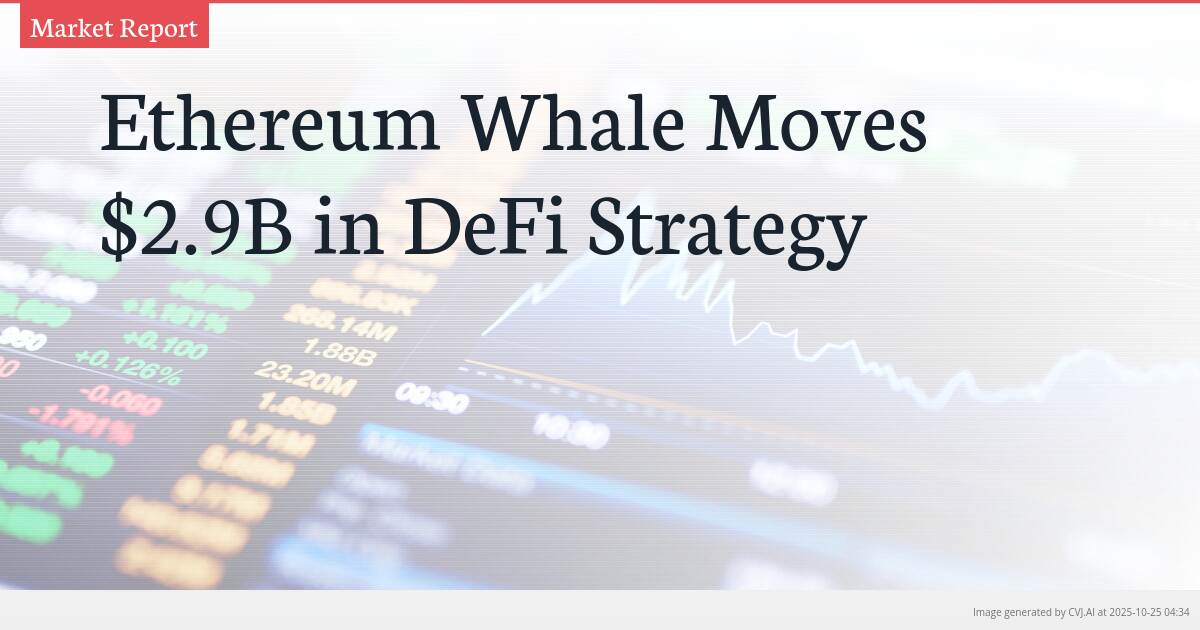This summary text is fully AI-generated and may therefore contain errors or be incomplete.
Introduction
A major Ethereum holder has executed a sophisticated $2.9 billion DeFi strategy involving Aave and new vault protocols, deploying massive liquidity just as Ethereum struggles to break above the $4,000 resistance level. The whale deposited 300,000 ETH as collateral to borrow $500 million USDT, then deployed it into ConcreteXYZ’s institutional-grade vaults, accounting for 64.5% of total deposits in a move that signals both confidence in DeFi infrastructure and potential market influence concerns.
Key Points
- Whale deposited 300,000 ETH into Aave as collateral to borrow $500M USDT for vault deployment
- ConcreteXYZ protocol connects institutional and DeFi capital through transparent, yield-bearing vaults
- Ethereum faces key technical resistance at $4,000-$4,200 with limited buyer conviction despite recent rebound
Whale's Sophisticated DeFi Maneuver
According to on-chain analytics platform Lookonchain, an Ethereum OG holding 736,316 ETH worth approximately $2.89 billion recently executed a complex liquidity strategy that has captured market attention. The whale deposited 300,000 ETH into Aave, one of the largest decentralized lending protocols, and borrowed $500 million USDT against this collateral. This approach allows the large holder to unlock substantial liquidity without selling their Ethereum holdings, maintaining exposure to ETH’s potential upside while accessing capital for yield opportunities.
The borrowed $500 million USDT was then deposited into vaults launched by ConcreteXYZ and Stable just before their official announcement. ConcreteXYZ represents a next-generation liquidity protocol designed to bridge institutional and DeFi capital through tokenized vaults that offer yield-bearing strategies while maintaining full transparency and composability within the Ethereum ecosystem. The timing of this massive deposit preceding the public reveal suggests either insider positioning or high-conviction participation in these new financial infrastructure products.
This single whale accounted for 64.5% of the total $775 million USDT deposited across the new vaults, highlighting both the scale of their operation and their dominant role in this sudden market activity. Such concentration from one entity raises important questions about market influence and systemic risk within the DeFi ecosystem, even as it demonstrates growing confidence among deep-pocketed players in the stability and profitability of decentralized finance infrastructure.
Market Implications of Massive Liquidity Move
The whale’s strategic deployment represents more than just a large transaction—it signals how sophisticated players are leveraging DeFi infrastructure to optimize capital efficiency and maintain market dominance. By using ETH as collateral rather than selling it, the whale preserves their long-term position in Ethereum while accessing stablecoin liquidity for yield farming opportunities. This approach demonstrates the maturity of DeFi protocols in serving institutional-scale capital movements while maintaining the composability that defines the Ethereum ecosystem.
The implications for Ethereum’s broader market dynamics are significant. If this borrowed liquidity is used for yield farming or strategic positioning rather than short-term speculation, it could reinforce Ethereum’s ecosystem fundamentals by increasing DeFi activity and on-chain engagement. However, the concentration also introduces potential risks—if market conditions deteriorate and collateral values decline, forced liquidations could amplify volatility across the ecosystem. The move highlights the delicate balance between DeFi innovation and systemic stability as institutional-scale capital flows through decentralized protocols.
This transaction occurs at a critical juncture for Ethereum’s price action, with the asset struggling to maintain momentum above key resistance levels. The whale’s confidence in deploying such substantial capital through DeFi infrastructure suggests underlying belief in Ethereum’s long-term value proposition, even as short-term technical indicators show uncertainty. The move also underscores the growing sophistication of yield optimization strategies available to large holders, who can now access institutional-grade returns while remaining within the transparent, composable DeFi ecosystem.
Ethereum's Technical Battle at $4,000
While whales execute sophisticated strategies, Ethereum’s price action reflects broader market uncertainty. Currently trading around $3,964, ETH shows signs of modest rebound after recent volatility but remains trapped below the crucial $4,000-$4,200 resistance zone. This area represents a significant technical barrier where both the 50-day and 100-day moving averages converge, creating a strong rejection zone that has consistently halted upward momentum during consolidation phases.
The daily chart indicates Ethereum has been attempting recovery from October lows, with the 200-day moving average near $3,200 providing dynamic support that has prevented deeper breakdowns. However, volume patterns suggest limited conviction among buyers, as each rally attempt has been met with fading strength. The inability to decisively break above $4,000 has left the asset vulnerable to renewed selling pressure should momentum weaken further.
For Ethereum to regain a sustainable bullish outlook, analysts point to the need for a decisive close above $4,200, which would signal potential continuation toward $4,500 and higher price targets. Conversely, failure to reclaim this range could lead to a retest of support levels between $3,600 and $3,500. The contrast between sophisticated whale activity and retail investor hesitation creates a complex market dynamic that will likely determine Ethereum’s near-term direction.
DeFi Evolution and Institutional Convergence
The whale’s massive deployment into ConcreteXYZ vaults highlights the ongoing evolution of DeFi infrastructure toward institutional-grade products. ConcreteXYZ’s design to connect institutional and DeFi capital through transparent, yield-bearing vaults represents the next phase of decentralized finance maturation. These protocols offer the composability and transparency that define DeFi while providing the reliability and scale demanded by institutional participants.
This convergence between traditional finance and decentralized protocols is accelerating, with large players increasingly using DeFi infrastructure for sophisticated capital management strategies. The ability to collateralize ETH holdings, borrow stablecoins, and deploy them into yield-generating vaults—all within the Ethereum ecosystem—demonstrates how DeFi has evolved from experimental protocols to practical financial infrastructure. However, the dominance of single entities in these markets raises important questions about decentralization ideals versus practical market realities.
As Ethereum continues its technical battle at $4,000, the underlying ecosystem demonstrates remarkable resilience and innovation. The sophisticated strategies employed by large holders signal confidence in Ethereum’s long-term value, even as short-term price action remains uncertain. The coming weeks will reveal whether retail sentiment aligns with whale conviction, potentially breaking the current resistance or confirming the need for further consolidation before the next significant move.
📎 Read the original article on newsbtc.com

